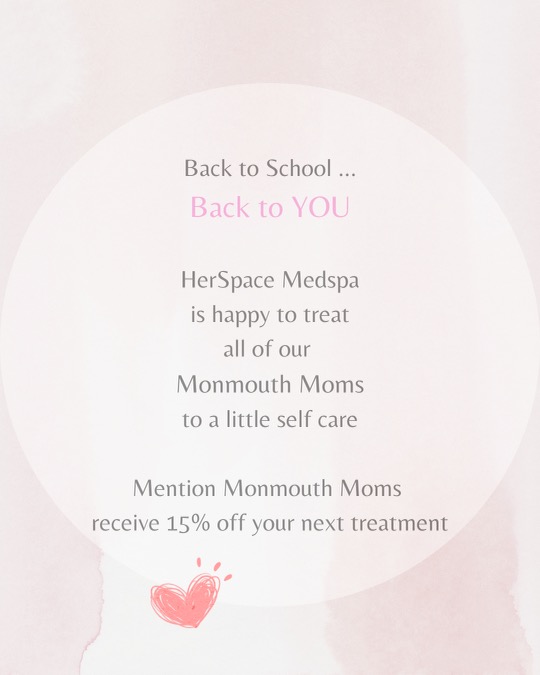Thinking about getting botox? We sat down with Jessica Roberts of HerSpace Med Spa in Little Silver, NJ, to discuss its cosmetic benefits, what to keep in mind beforehand, how it’s used for various medical conditions, and more! Read more below, and check out a special deal just for The Monmouth Moms!
What are some benefits of getting Botox?
Botox is commonly used for cosmetic purposes to reduce the appearance of wrinkles and fine lines.
Its benefits include:
1. Wrinkle reduction: Botox temporarily relaxes muscles, smoothing out wrinkles and lines, especially in the forehead and around the eyes. 2. Non-surgical: It’s a non-invasive procedure, often referred to as a “lunchtime” treatment, with minimal downtime.
3. Quick results: You can see improvements within a few days, with the full effect usually achieved within 1-2 weeks.
4. Long-lasting: Botox results typically last 3 months, depending on the individual.
5. Preventative: Some use Botox to prevent new wrinkles from forming by inhibiting muscle movement.
6. Safety: Impressive safety profile with minimal side effects.
What should you keep in mind before your Botox appointment?
Before your Botox appointment, there are several important things to keep in mind:
1. Choose a qualified provider: Ensure you go to a licensed and experienced medical professional who is trained in administering Botox.
2. Consultation: Schedule a consultation to discuss your goals, expectations, and any concerns with your provider. They can help determine if Botox is right for you.
3. Medical history: Inform your provider about your medical history, including any allergies, previous treatments, or medications you’re taking. Be honest about any previous adverse reactions to Botox.
4. Set realistic expectations: Understand that Botox provides temporary results and may not completely eliminate all wrinkles. Discuss your desired outcome with your provider to set realistic expectations.
5. Preparation: Avoid taking blood-thinning medications, alcohol, and certain supplements, such as fish oil, for a few days before your appointment, as they can increase the risk of bruising.
6. Post-care: Discuss post-treatment care with your provider. You may be advised to avoid strenuous exercise, lying down, or rubbing the treated area for a few hours after the procedure.
7. Cost and payment: Understand the cost of the procedure and the payment process in advance. Botox is usually priced per unit, and the total cost depends on the areas treated.
8. Ask questions: Don’t hesitate to ask any questions or seek clarification about the procedure, potential side effects, and aftercare instructions. By keeping these factors in mind and having a thorough discussion with your provider, you can ensure a safe and satisfactory Botox experience.
Does the procedure hurt?
Most people describe Botox injections as relatively painless or only mildly uncomfortable. Here are a few factors to consider:
1. Needle size: The needles used for Botox injections are very fine, so the discomfort is typically minimal.
2. Pain tolerance: Pain perception varies from person to person. However, most describe the experience as a slight bug bite sensation.
3. Area of treatment: Sensation can vary depending on the area being treated. For example, injections in more sensitive areas, like around the lips or eyes, may be slightly more uncomfortable.
4. Topical anesthetics: We offer topical numbing creams or ice packs to minimize discomfort before the injections. Overall, while you may feel a brief sensation during the injections, it’s generally considered tolerable and quick, with any discomfort subsiding shortly after the procedure.
Other than aesthetic purposes, what are some of the other benefits of using Botox?
Beyond its cosmetic uses, Botox has several medical and therapeutic applications, including: **Medical Conditions**: Botox is used to treat various medical conditions, such as:
**Chronic Migraines**: It can reduce the frequency and severity of chronic migraine headaches.
**Hyperhidrosis**: Botox can help control excessive sweating, particularly in the underarms, hands, and feet.
**Muscle Spasms**: It’s used to alleviate muscle spasms and contractions, including those associated with cerebral palsy and dystonia.
**Eye Conditions**: Botox can be used to treat certain eye conditions, like strabismus (crossed eyes) and blepharospasm (eyelid twitching).
**Overactive Bladder**: Botox injections in the bladder can help manage overactive bladder symptoms, reducing urinary frequency and urgency.
**Neurological Disorders**: In some cases, Botox is used to manage symptoms of neurological disorders like Parkinson’s disease and multiple sclerosis.
**TMJ Disorder**: Botox can provide relief from temporomandibular joint (TMJ) disorder by reducing muscle tension in the jaw. **Depression**: Emerging research suggests that Botox injections may have a positive impact on mood in some individuals by reducing the ability to frown, potentially helping with symptoms of depression.
**Acne**: While not as common as other treatments, Botox may be used to reduce oil production and decrease the size of pores in some cases of acne.
Is it true you should switch between different Botox brands for longer lasting results?
There is no scientific evidence to support the idea that switching between different Botox brands will result in longer-lasting effects. Botox is a brand name for a specific type of botulinum toxin, and it has been extensively tested and approved for various cosmetic and medical uses. The duration of Botox’s effects is influenced by factors like the dosage, the area treated, an individual’s metabolism, and their unique response to the treatment.
However, the idea of switching between brands to extend the results is not an uncommon practice in the aesthetic community. Some patients prefer one brand over the other. Speak to your provider about the different options and what would be best for your goals.





